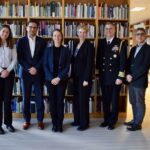Insights from the Stockholm Climate Security Hub Showcase at World Water Week.
Written by Charlotte Grech-Madin
UNESCO Cat. II International Centre for Water Cooperation, and Uppsala University, Sweden
In recent years, we have seen climate security increasingly move to the centre of the security debate. Once part of “low politics,” or matters not vital to a state, it is now featured in international discourse as “high politics” fundamental to a state’s survival and security. The recent climate security showcase at World Water Week is testament to this focus. Convened by the Stockholm Climate Security Hub, the showcase highlighted the link between climate-driven hazards and security.
The UN Security Council (UNSC) has held high-level debates on water security in 2016, climate-related security risks in 2018, and climate-related disasters and peace in January this year. These place due focus on the climate as indispensable to all aspects of society. Some actors have also identified climate change as a “threat multiplier” for other security risks. Sweden actively promoted climate security as a thematic priority of its UNSC residency in 2017–2018, a plea that has been taken up by other states. Sweden championed early intervention and resilience building through integrated climate risk assessments and management strategies. But there is still some resistance to putting climate security on the agenda; as Inger Buxton of the Swedish Foreign Ministry observed, there is a need to strengthen the political will of UN member states.
A common thread among the speakers at the showcase was the importance of raising attention to climate security through its connection to human security. All speakers highlighted the “human face” of climate related conflict risks, sometimes in achingly tragic terms. These images capture public consciousness, more so than environmental discourse alone, and may help maintain and attract development support.

Speakers of the showcase vividly outlined the human costs of climate-driven hazards. Elizabeth van Duin of the Dutch Infrastructure and Water Ministry set the scene, highlighting the human effects of too little water, and too much. She also highlighted what I interpret as a form of climate injustice, where the poorest communities who have typically contributed least to global climatic changes are suffering the most. The poor are also least able to escape that suffering, leading them into a poverty trap and constant insecurity. Poverty, a widening gap between rich and poor, and migration, all undermine progress in achieving the UN 2030 Agenda for Sustainable Development.
Within the African continent, Muna Luqman of the Yemeni women-led organisation Food4Humanity, and Alier Oka of the South Sudanese Water Ministry, outlined many of these dynamics on the ground. Both their countries experience a growing population, variable water supply with droughts and floods, disease outbreaks, and conflict at the internationalised and pastoralist levels respectively. The 2019 UNICEF report “Water Under Fire” conveys that more children die from diseases carried by contaminated water than from direct violence. A lack of clean water can be “just as deadly as a bullet or bomb.” UNICEF’s message particularly captures the situation in Yemen. Muna and Alier’s insights into the lived reality of climate-driven hazards are alarming, and deserve serious attention. South Sudan has developed some international development partnerships, notably with The Netherlands. Yemen still has a long way to go.
“We need to strike the right balance between bottom-up ownership of climate adaptation, and top-down assistance such as emergency relief. “
Turning to the Middle East, Shaddad Al-Attili of the PLO Negotiations Affairs Department in Gaza outlined the impacts of attacks on water infrastructure, and the use of water to meet military objectives in conflict. This is all the more salient given the aridity of Gaza; water has heightened military value in a context of water scarcity.
As I interpret it, the showcase generated four crucial conclusions. First, we must pursue locally generated resilience. We need to strike the right balance between bottom-up ownership of climate adaptation, and top-down assistance such as emergency relief. Communities need assistance that can empower them to manage their climate risks and security. To this end, skills training, capacity building and transfer of knowledge and technology is vital to avoid dependency at the local level. This also speaks to the balance between short-term assistance and long-term, sustainable assistance.
Second, resilience should be anticipatory. This can include risk assessments and management strategies that use early warning systems for climate-driven hazards, and better urban planning that considers future flood risks and water supply issues.
Third, we need to strengthen monitoring and accountability of international humanitarian law around water. The 1977 Additional Protocols I and II to the Geneva Conventions specify the protection of water resources indispensible to a civilian population in conflict, and prohibit attacks on installations containing dangerous forces such as dams and dykes. These principles must be better integrated into military manuals and training.
Fourth, we need more women at the table in climate and water negotiations. Women are highly engaged in local water collection, and hold key local insights. When they are brought to the table, they should not only be seen as fulfilling a gender quota. Put simply, we should not just count the women, but also make those women count.
Ultimately, climate-driven hazards do not operate in isolation, but are intimately interlinked with many, if not all, aspects of development, security and foreign policy. This is reflected in the UN 2030 Agenda that implores us to bring the many faces of development together for a more secure world.








